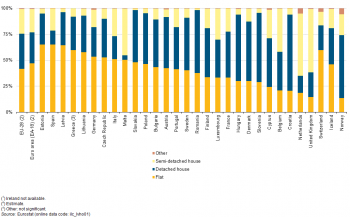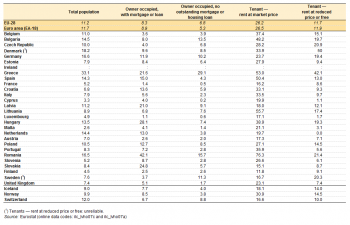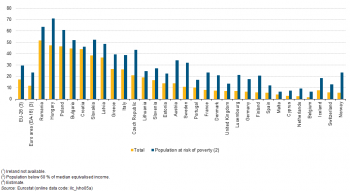Archive:Housing statistics
- Data from March 2014. Most recent data: Further Eurostat information, Main tables and Database. Planned article update: April 2015.

(% of population) - Source: Eurostat (ilc_lvho01)

(% of population) - Source: Eurostat (ilc_lvho07c) and (ilc_lvho07a)
This article provides an overview of recent statistics on housing in the European Union (EU) and EFTA countries, focusing on dwelling types, tenure status (owning or renting a property), housing quality and affordability.
Decent housing, at an affordable price in a safe environment, is a fundamental need and right. Ensuring this need is met, which is likely to alleviate poverty and social exclusion, is still a significant challenge in a number of European countries.
Main statistical findings
Type of dwelling
In 2012, 41.6 % of the EU-28 population lived in flats, just over one third (34.0 %) in detached houses and 23.7 % in semi-detached houses. The share of persons living in flats was highest across the EU Member States in Estonia (65.1 %), Spain (65.0 %) and Latvia (64.4 %). The share of people living in detached houses peaked in Croatia (73.0 %), Slovenia (66.6 %), Hungary (63.9 %), Romania (60.5 %) and Denmark (57.1 %); Norway also reported a high share (60.7 %) of its population living in detached houses. The highest propensities to live in semi-detached houses were reported in the United Kingdom (60.9 %) and in the Netherlands (60.0 %) — see Figure 1.
Tenure status
In 2012 over one quarter (27.2 %) of the EU-28 population lived in an owner-occupied home for which there was an outstanding loan or mortgage, while more than two fifths (43.4 %) of the population lived in an owner-occupied home without a loan or mortgage. As such, just over seven out of every 10 (70.6 %) persons in the EU-28 lived in owner-occupied dwellings, while 18.5 % were tenants with a market price rent, and 10.9 % tenants in reduced-rent or free accommodation.
More than half of the population in each EU Member State (see Figure 2) lived in owner-occupied dwellings in 2012, ranging from 53.2 % in Germany up to 96.6 % in Romania. In Switzerland, the proportion of people who lived in rented dwellings outweighed those living in owner-occupied dwellings, as some 56.1 % of the population were tenants. In Sweden (70.1 %), the Netherlands (59.9 %) and Denmark (51.8 %) more than half of the population lived in owner-occupied dwellings with an outstanding loan or mortgage; this was also the case in Norway (64.9 %) and Iceland (62.7 %).
The share of persons living in rented dwellings with a market price rent in 2012 was less than 10.0 % in 11 of the EU Member States. By contrast, close to two fifths of the population in Germany lived in rented dwellings with a market price rent as did more than one third of the population in Denmark, more than one quarter in the Netherlands, Sweden and Austria, and more than one fifth in Luxembourg. This share was even higher in Switzerland where it reached 51.6 %. The share of the population living in a dwelling with a reduced price rent or occupying a dwelling free of charge was less than 20.0 % in all EU Member States.
Housing quality
One of the key dimensions in assessing the quality of housing conditions is the availability of sufficient space in the dwelling. The overcrowding rate describes the proportion of people living in an overcrowded dwelling, as defined by the number of rooms available to the household, the household’s size, as well as its members’ ages and their family situation.
In 2012, 17.2 % of the EU-28 population lived in overcrowded dwellings (see Figure 3); the highest overcrowding rates were registered in Romania (51.6 %), Hungary (47.2 %), Poland (46.3 %), Bulgaria (44.5 %) and Croatia (44.1 %). By contrast, Belgium (1.6 %), the Netherlands (2.5 %) and Cyprus (2.8 %) recorded the lowest rates of overcrowding, while eight other EU Member States (as well as Norway, Switzerland and Iceland) all reported less than 10.0 % of their respective populations living in overcrowded housing. The largest increase between 2011 and 2012 in the share of the population living in overcrowded dwellings was reported by Austria (its share rising by 2.3 percentage points).
Within the population at risk of poverty (in other words, people living in households where equivalised disposable income per person was below 60 % of the national median), the overcrowding rate in the EU-28 was 29.4 % in 2012, some 12.2 percentage points above the rate for the whole population. The highest overcrowding rates among the population at risk of poverty were registered in Hungary (71.0 %), Romania (63.7 %) and Poland (60.8 %), while more than half of all persons at risk of poverty in Slovakia and Bulgaria also lived in overcrowded housing. At the other end of the range, the lowest overcrowding rates for those at risk of poverty were recorded in the Netherlands (9.2 %), Cyprus (7.5 %), Malta (6.6 %) and Belgium (6.4 %); these were the only EU Member States to report that fewer than one in 10 persons at risk of poverty were living in overcrowded conditions (see Figure 3).
In addition to overcrowding, some other aspects of housing deprivation — such as the lack of a bath or a toilet, a leaking roof in the dwelling, or a dwelling considered as being too dark — are taken into account to build a more complete indicator of housing quality. The severe housing deprivation rate is defined as the proportion of persons living in a dwelling which is considered as being overcrowded, while having at the same time at least one of these aforementioned housing deprivation measures. Across the EU-28 as a whole, 5.1 % of the population suffered from severe housing deprivation in 2012 (see Figure 4). There were five EU Member States where more than one in 10 of the population faced severe housing deprivation in 2012, with the share rising to 17.2 % in Hungary and peaking at just over one in five persons (22.8 %) in Romania. By contrast, less than 1.0 % of the population in the Netherlands, Finland and Belgium faced severe housing deprivation in 2012. The overall proportion of people within the EU-28 experiencing severe housing deprivation decreased by 0.4 percentage points between 2011 and 2012. The largest decreases occurred in Romania (-3.1 percentage points), in Bulgaria (-1.4 percentage points) and in Latvia (-1.1 percentage points). The largest increase in the proportion of people experiencing severe housing deprivation was reported by Hungary, up 1.2 percentage points between 2011 and 2012.
Housing affordability
In 2012, an 11.2 % share of the EU-28 population lived in households that spent 40 % or more of their equivalised disposable income on housing (see Table 1). The proportion of the population whose housing costs exceeded 40 % of their equivalised disposable income was highest for tenants with market price rents (26.2 %) and lowest for persons in owner-occupied dwellings without a loan or mortgage (6.8 %).
The EU-28 average masks significant differences between Member States: at one extreme there were a number of countries where a relatively small proportion of the population lived in households where housing costs exceeded 40 % of their disposable income, notably Malta (2.6 %), Cyprus (3.3 %), Finland (4.5 %), Luxembourg (4.9 %) as well as France and Slovenia (both 5.2 %). At the other extreme, around one third of the population in Greece (33.1 %) and around one fifth of the population in Denmark (18.2 %) spent more than 40 % of their equivalised disposable income on housing; these Member States were followed by Germany (16.6 %), Romania (16.5 %), Bulgaria (14.5 %), the Netherlands (14.4 %) and Spain (14.3 %).
Data sources and availability
The data used in this section are primarily derived from microdata from EU statistics on income and living conditions (EU-SILC). The reference population is all private households and their current members residing in the territory of an EU Member State at the time of data collection; persons living in collective households and in institutions are generally excluded from the target population. The EU-28 aggregate is a population-weighted average of individual national figures.
Context
The EU does not have any specific responsibilities with respect to housing; rather, national governments develop their own housing policies. Nevertheless, many of the EU Member States face similar challenges: for example, how to renew housing stocks, how to plan and combat urban sprawl, how to promote sustainable development, how to help young and disadvantage groups to get into the housing market, or how to promote energy efficiency among homeowners.
As such, questions of social housing, homelessness or integration play an important role within the EU’s social policy agenda. The charter of fundamental rights stipulates in Article IV-34 that ‘in order to combat social exclusion and poverty, the Union recognises and respects the right to social and housing assistance so as to ensure a decent existence for all those who lack sufficient resources, in accordance with Community law and national laws and practices’. Within this context, a European Council meeting in Nice in 2000, reached an agreement on a set of common objectives for the EU’s strategy against poverty and social exclusion, including two objectives related to housing, namely ‘to implement policies which aim to provide access for all to decent and sanitary housing, as well as basic services necessary to live normally having regard to local circumstances (electricity, water, heating, etc.)’ and ‘to put in place policies which seek to prevent life crises, which can lead to situations of social exclusion, such as indebtedness, exclusion from school and becoming homeless.’ This remit was extended in 2010 when the European platform against poverty and social exclusion (COM(2010) 758 final) set out a series of actions to help reduce the number of people at risk of poverty or social exclusion by at least 20 million persons by 2020 (compared with 2008) — see also the article on social inclusion statistics.
See also
- Housing conditions
- Housing price statistics - house price index
- Income distribution statistics
- People at risk of poverty or social exclusion
- Statistics on European cities
Further Eurostat information
Publications
- European social statistics (2013) — Statistical books
- Employment and Social Situation Quarterly Review — September 2013
- Employment and Social Developments in Europe (2013)
- European social statistics (2013) — Statistical books
- Housing conditions in Europe (2009) — Statistics in focus 4/2011
- Income and living conditions in Europe (2010) — Statistical books
- The social situation in the European Union (2009) — Statistical books
- Combating poverty and social exclusion (2010) — Statistical books
Main tables
- Income and living conditions (t_ilc), see
- Living conditions (t_ilc_lv)
- Housing conditions (t_ilc_lvho)
- Material deprivation (t_ilc_md)
- Housing deprivation (t_ilc_mdho)
- Living conditions (t_ilc_lv)
Database
- Income and living conditions (ilc), see
- Living conditions (ilc_lv)
- Housing conditions (ilc_lvho)
- Material deprivation (ilc_md)
- Housing deprivation (ilc_mdho)
- Environment of the dwelling (ilc_mddw)
- Living conditions (ilc_lv)
Dedicated section
Methodology / Metadata
- Income and living conditions (ESMS metadata file — ilc_esms)
- The production of data on homelessness and housing deprivation in the European Union: survey and proposals
Source data for tables and figures (MS Excel)
![]() Housing statistics: tables and figures
Housing statistics: tables and figures
Other information
- Regulation 1177/2003 of 16 June 2003 concerning Community statistics on income and living conditions (EU-SILC)
- Regulation 1553/2005 of 7 September 2005 amending Regulation 1177/2003 concerning Community statistics on income and living conditions (EU-SILC)
- Regulation 1791/2006 of 20 November 2006 adapting certain Regulations and Decisions in the fields of ... statistics, ..., by reason of the accession of Bulgaria and Romania
External links
- OECD — Housing
- The Housing Sector in Europe — Household Consumption Long Term and During the Crisis — Peter Parlasca, RICS research report, October 2013
- United Nations — Housing and its environment
- WHO — Housing


